This article brings you relevant knowledge aboutSQL, which mainly organizes issues related to window functions. SQL window functions are provided for online analytical processing (OLAP) and business intelligence (BI). It has complex analysis and report statistics functions, such as cumulative sales statistics of products, category rankings, year-on-year/month-on-month analysis, etc. Let’s take a look at it together. I hope it will be helpful to everyone.

Recommended study: "SQL Tutorial"
SQL window function is for online analysis Processing (OLAP) and business intelligence (BI) provide complex analysis and report statistics functions, such as cumulative sales statistics of products, category rankings, year-on-year/month-on-month analysis, etc. These features are often difficult to implement with aggregate functions and grouping operations.
Window function (Window Function) can analyze a set of data and return results like an aggregate function. The difference between the two is that the window function does not summarize a set of data into a single result, but instead Each row of data returns a result. The difference between aggregate functions and window functions is shown in the figure below.

Take the SUM function as an example to demonstrate the difference between the two functions. SUM() in the following statement is an aggregate function:
SELECT SUM(salary) AS "所有员工月薪总和" FROM employee
The above SUM function Can be used as an aggregate function to summarize all employee data into one result. Therefore, the query returns the total monthly salary of all employees:
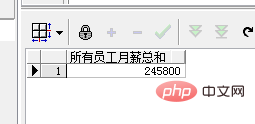
SUM() in the following statement is a window function:
SELECT emp_name AS "员工姓名", SUM(salary) OVER () AS "所有员工月薪总和" FROM employee;
Among them, the keyword OVER Indicates that SUM() is a window function. Empty brackets indicate that all data are summarized as one group. The results returned by this query are as follows:
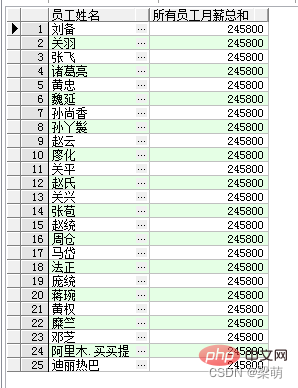
The above query results return all employee names, and the same summary result is returned for each employee through the aggregate function SUM() .
As you can see from the above example, the syntax of the window function is different from that of the aggregate function in that it contains an OVER clause. The OVER clause is used to specify a window for data analysis. The complete window function is defined as follows:

where window_function is the name of the window function and expression is an optional analysis object ( field name or expression), the OVER clause includes three options: partition (PARTITION BY), sorting (ORDER BY), and window size (frame_clause).
Tip: The aggregate function summarizes multiple rows of data in the same group into a single result, while the window function retains all the original data. In some databases, window functions are also called online analytical processing (OLAP) functions, or analytical functions.
The PARTITION BY option in the OVER clause of the window function is used to define partitions, and its role is similar to that in the query statement GROUP BY clause. If we specify the partition option, the window function will analyze each partition separately.
For example, the following statement counts the total monthly salary of employees according to different departments:
SELECT emp_name AS "员工姓名", salary "月薪", dept_id AS "部门编号", SUM(salary) OVER ( PARTITION BY dept_id ) AS "部门合计" FROM employee;
Among them, the PARTITION BY option indicates partitioning by department. The results returned by the query are as follows:
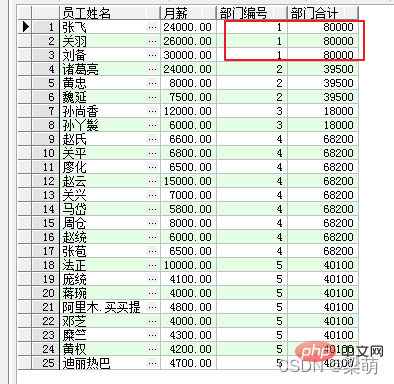
The first three rows of data in the query results belong to the same department, so their corresponding department total fields are equal to 80000 (30000 26000 24000). Employees in other departments are counted in the same way.
Tip: After specifying the PARTITION BY option in the window function OVER clause, we can obtain group statistical results without using the GROUP BY clause.
If the PARTITION BY option is not specified, it means that all data will be analyzed as a whole.
The ORDER BY option in the OVER clause of the window function is used to specify the sorting method of the data in the partition, and its function is similar to the ORDER BY clause in the query statement.
Sort options are usually used for categorical ranking of data. For example, the following statement is used to analyze the monthly salary ranking of employees within the department:
SELECT emp_name AS "员工姓名", salary "月薪", dept_id AS "部门编号", RANK() OVER ( PARTITION BY dept_id ORDER BY salary DESC ) AS "部门内排名" FROM employee;
Among them, the RANK function is used to calculate the ranking of the data, the PARTITION BY option indicates partitioning by department, and the ORDER BY option indicates that within the department, the Monthly salary is sorted from high to low. The results returned by the query are as follows:
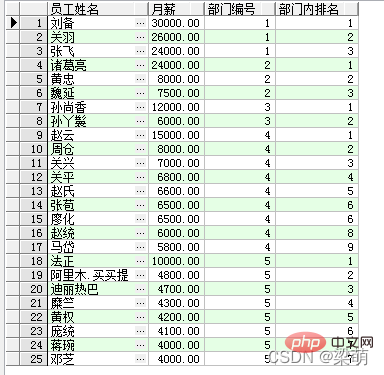
查询结果中的前3行数据属于同一个部门:“刘备”的月薪最高,在部门内排名第1;“关羽”排名第2;“张飞”排名第3。其他部门的员工采用同样的方式进行排名。
提示:窗口函数OVER子句中的ORDER BY选项和查询语句中的ORDER BY子句的使用方法相同。因此,也可以使用NULLS FIRST或者NULLS LAST选项指定空值的排序位置。
窗口函数OVER子句中的frame_clause选项用于指定一个移动的分析窗口,窗口总是位于分区的范围之内,是分区的一个子集。在指定了分析窗口之后,窗口函数不再基于分区进行分析,而是基于窗口内的数据进行分析。
窗口选项可以用于实现各种复杂的分析功能,例如计算累计到当前日期为止的销售额总和,每个月及其前后各N个月的平均销售额等。
指定窗口大小的具体选项如下:

其中,ROWS表示以数据行为单位计算窗口的偏移量,RANGE表示以数值(例如10天、5km等)为单位计算窗口的偏移量。
frame_start选项用于定义窗口的起始位置,可以指定以下内容之一:
●UNBOUNDED PRECEDING——表示窗口从分区的第一行开始。
●N PRECEDING——表示窗口从当前行之前的第N行开始。
●CURRENT ROW——表示窗口从当前行开始。
frame_end选项用于定义窗口的结束位置,可以指定以下内容之一:
●CURRENT ROW——表示窗口到当前行结束。
●M FOLLOWING——表示窗口到当前行之后的第M行结束。
●UNBOUNDED FOLLOWING——表示窗口到分区的最后一行结束。
下图说明了这些窗口大小选项的含义
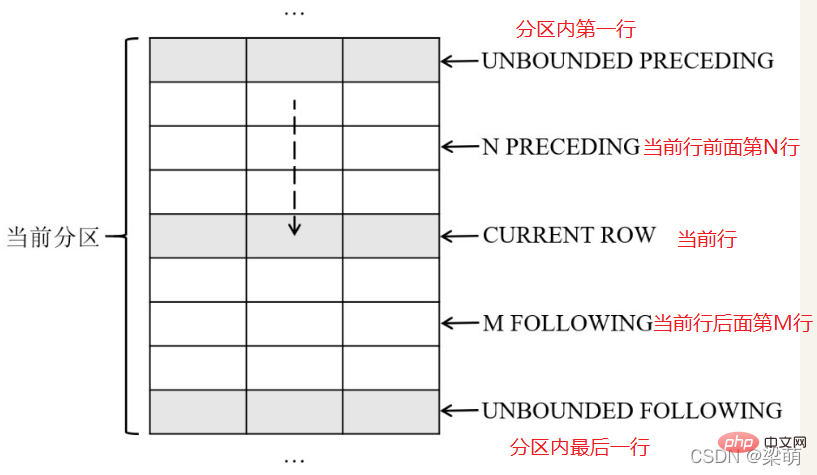
下面语句表示分析窗口从当前分区的第一行开始,直到当前行结束,即对应到图中前面5行记录。
ROWS BETWEEN UNBOUNDED PRECEDING AND CURRENT ROW
许多常见的聚合函数也可以作为窗口函数使用,包括AVG()、SUM()、COUNT()、MAX()以及MIN()等函数。
SQL窗口函数-聚合窗口函数
排名窗口函数用于对数据进行分组排名,包括ROW_NUMBER()、RANK()、DENSE_RANK()、PERCENT_RANK()、CUME_DIST()以及NTILE()等函数。
SQL窗口函数-排名窗口函数
取值窗口函数用于返回指定位置上的数据行,包括FIRST_VALUE()、LAST_VALUE()、LAG()、LEAD()、NTH_VALUE()等函数。
SQL窗口函数-取值窗口函数
--员工信息表 CREATE TABLE employee ( emp_id NUMBER , emp_name VARCHAR2(50) NOT NULL , sex VARCHAR2(10) NOT NULL , dept_id INTEGER NOT NULL , manager INTEGER , hire_date DATE NOT NULL , job_id INTEGER NOT NULL , salary NUMERIC(8,2) NOT NULL , bonus NUMERIC(8,2) , email VARCHAR2(100) NOT NULL , comments VARCHAR2(500) , create_by VARCHAR2(50) NOT NULL , create_ts TIMESTAMP NOT NULL , update_by VARCHAR2(50) , update_ts TIMESTAMP ) ; COMMENT ON TABLE employee IS '员工信息表'; COMMENT ON COLUMN employee.emp_id IS '员工编号,自增主键'; COMMENT ON COLUMN employee.emp_name IS '员工姓名'; COMMENT ON COLUMN employee.sex IS '性别'; COMMENT ON COLUMN employee.dept_id IS '部门编号'; COMMENT ON COLUMN employee.manager IS '上级经理'; COMMENT ON COLUMN employee.hire_date IS '入职日期'; COMMENT ON COLUMN employee.job_id IS '职位编号'; COMMENT ON COLUMN employee.salary IS '月薪'; COMMENT ON COLUMN employee.bonus IS '年终奖金'; COMMENT ON COLUMN employee.email IS '电子邮箱'; COMMENT ON COLUMN employee.comments IS '备注信息'; COMMENT ON COLUMN employee.create_by IS '创建者'; COMMENT ON COLUMN employee.create_ts IS '创建时间'; COMMENT ON COLUMN employee.update_by IS '修改者'; COMMENT ON COLUMN employee.update_ts IS '修改时间'; INSERT INTO employee(EMP_ID,emp_name, sex, dept_id, manager, hire_date, job_id, salary, bonus, email, comments, create_by, create_ts, update_by, update_ts) VALUES (1,'刘备', '男', 1, NULL, DATE '2000-01-01', 1, 30000, 10000, 'liubei@shuguo.com', NULL, 'Admin', TIMESTAMP '2000-01-01 10:00:00', NULL, NULL); INSERT INTO employee(EMP_ID,emp_name, sex, dept_id, manager, hire_date, job_id, salary, bonus, email, comments, create_by, create_ts, update_by, update_ts) VALUES (2,'关羽', '男', 1, 1, DATE '2000-01-01', 2, 26000, 10000, 'guanyu@shuguo.com', NULL, 'Admin', TIMESTAMP '2000-01-01 10:00:00', NULL, NULL); INSERT INTO employee(EMP_ID,emp_name, sex, dept_id, manager, hire_date, job_id, salary, bonus, email, comments, create_by, create_ts, update_by, update_ts) VALUES (3,'张飞', '男', 1, 1, DATE '2000-01-01', 2, 24000, 10000, 'zhangfei@shuguo.com', NULL, 'Admin', TIMESTAMP '2000-01-01 10:00:00', NULL, NULL); INSERT INTO employee(EMP_ID,emp_name, sex, dept_id, manager, hire_date, job_id, salary, bonus, email, comments, create_by, create_ts, update_by, update_ts) VALUES (4,'诸葛亮', '男', 2, 1, DATE '2006-03-15', 3, 24000, 8000, 'zhugeliang@shuguo.com', NULL, 'Admin', TIMESTAMP '2006-03-15 10:00:00', NULL, NULL); INSERT INTO employee(EMP_ID,emp_name, sex, dept_id, manager, hire_date, job_id, salary, bonus, email, comments, create_by, create_ts, update_by, update_ts) VALUES (5,'黄忠', '男', 2, 4, DATE '2008-10-25', 4, 8000, NULL, 'huangzhong@shuguo.com', NULL, 'Admin', TIMESTAMP '2008-10-25 10:00:00', NULL, NULL); INSERT INTO employee(EMP_ID,emp_name, sex, dept_id, manager, hire_date, job_id, salary, bonus, email, comments, create_by, create_ts, update_by, update_ts) VALUES (6,'魏延', '男', 2, 4, DATE '2007-04-01', 4, 7500, NULL, 'weiyan@shuguo.com', NULL, 'Admin', TIMESTAMP '2007-04-01 10:00:00', NULL, NULL); INSERT INTO employee(EMP_ID,emp_name, sex, dept_id, manager, hire_date, job_id, salary, bonus, email, comments, create_by, create_ts, update_by, update_ts) VALUES (7,'孙尚香', '女', 3, 1, DATE '2002-08-08', 5, 12000, 5000, 'sunshangxiang@shuguo.com', NULL, 'Admin', TIMESTAMP '2002-08-08 10:00:00', NULL, NULL); INSERT INTO employee(EMP_ID,emp_name, sex, dept_id, manager, hire_date, job_id, salary, bonus, email, comments, create_by, create_ts, update_by, update_ts) VALUES (8,'孙丫鬟', '女', 3, 7, DATE '2002-08-08', 6, 6000, NULL, 'sunyahuan@shuguo.com', NULL, 'Admin', TIMESTAMP '2002-08-08 10:00:00', NULL, NULL); INSERT INTO employee(EMP_ID,emp_name, sex, dept_id, manager, hire_date, job_id, salary, bonus, email, comments, create_by, create_ts, update_by, update_ts) VALUES (9,'赵云', '男', 4, 1, DATE '2005-12-19', 7, 15000, 6000, 'zhaoyun@shuguo.com', NULL, 'Admin', TIMESTAMP '2005-12-19 10:00:00', 'Admin', TIMESTAMP '2006-12-31 10:00:00'); INSERT INTO employee(EMP_ID,emp_name, sex, dept_id, manager, hire_date, job_id, salary, bonus, email, comments, create_by, create_ts, update_by, update_ts) VALUES (10,'廖化', '男', 4, 9, DATE '2009-02-17', 8, 6500, NULL, 'liaohua@shuguo.com', NULL, 'Admin', TIMESTAMP '2009-02-17 10:00:00', NULL, NULL); INSERT INTO employee(EMP_ID,emp_name, sex, dept_id, manager, hire_date, job_id, salary, bonus, email, comments, create_by, create_ts, update_by, update_ts) VALUES (11,'关平', '男', 4, 9, DATE '2011-07-24', 8, 6800, NULL, 'guanping@shuguo.com', NULL, 'Admin', TIMESTAMP '2011-07-24 10:00:00', NULL, NULL); INSERT INTO employee(EMP_ID,emp_name, sex, dept_id, manager, hire_date, job_id, salary, bonus, email, comments, create_by, create_ts, update_by, update_ts) VALUES (12,'赵氏', '女', 4, 9, DATE '2011-11-10', 8, 6600, NULL, 'zhaoshi@shuguo.com', NULL, 'Admin', TIMESTAMP '2011-11-10 10:00:00', NULL, NULL); INSERT INTO employee(EMP_ID,emp_name, sex, dept_id, manager, hire_date, job_id, salary, bonus, email, comments, create_by, create_ts, update_by, update_ts) VALUES (13,'关兴', '男', 4, 9, DATE '2011-07-30', 8, 7000, NULL, 'guanxing@shuguo.com', NULL, 'Admin', TIMESTAMP '2011-07-30 10:00:00', NULL, NULL); INSERT INTO employee(EMP_ID,emp_name, sex, dept_id, manager, hire_date, job_id, salary, bonus, email, comments, create_by, create_ts, update_by, update_ts) VALUES (14,'张苞', '男', 4, 9, DATE '2012-05-31', 8, 6500, NULL, 'zhangbao@shuguo.com', NULL, 'Admin', TIMESTAMP '2012-05-31 10:00:00', NULL, NULL); INSERT INTO employee(EMP_ID,emp_name, sex, dept_id, manager, hire_date, job_id, salary, bonus, email, comments, create_by, create_ts, update_by, update_ts) VALUES (15,'赵统', '男', 4, 9, DATE '2012-05-03', 8, 6000, NULL, 'zhaotong@shuguo.com', NULL, 'Admin', TIMESTAMP '2012-05-03 10:00:00', NULL, NULL); INSERT INTO employee(EMP_ID,emp_name, sex, dept_id, manager, hire_date, job_id, salary, bonus, email, comments, create_by, create_ts, update_by, update_ts) VALUES (16,'周仓', '男', 4, 9, DATE '2010-02-20', 8, 8000, NULL, 'zhoucang@shuguo.com', NULL, 'Admin', TIMESTAMP '2010-02-20 10:00:00', NULL, NULL); INSERT INTO employee(EMP_ID,emp_name, sex, dept_id, manager, hire_date, job_id, salary, bonus, email, comments, create_by, create_ts, update_by, update_ts) VALUES (17,'马岱', '男', 4, 9, DATE '2014-09-16', 8, 5800, NULL, 'madai@shuguo.com', NULL, 'Admin', TIMESTAMP '2014-09-16 10:00:00', NULL, NULL); INSERT INTO employee(EMP_ID,emp_name, sex, dept_id, manager, hire_date, job_id, salary, bonus, email, comments, create_by, create_ts, update_by, update_ts) VALUES (18,'法正', '男', 5, 2, DATE '2017-04-09', 9, 10000, 5000, 'fazheng@shuguo.com', NULL, 'Admin', TIMESTAMP '2017-04-09 10:00:00', NULL, NULL); INSERT INTO employee(EMP_ID,emp_name, sex, dept_id, manager, hire_date, job_id, salary, bonus, email, comments, create_by, create_ts, update_by, update_ts) VALUES (19,'庞统', '男', 5, 18, DATE '2017-06-06', 10, 4100, 2000, 'pangtong@shuguo.com', NULL, 'Admin', TIMESTAMP '2017-06-06 10:00:00', NULL, NULL); INSERT INTO employee(EMP_ID,emp_name, sex, dept_id, manager, hire_date, job_id, salary, bonus, email, comments, create_by, create_ts, update_by, update_ts) VALUES (20,'蒋琬', '男', 5, 18, DATE '2018-01-28', 10, 4000, 1500, 'jiangwan@shuguo.com', NULL, 'Admin', TIMESTAMP '2018-01-28 10:00:00', NULL, NULL); INSERT INTO employee(EMP_ID,emp_name, sex, dept_id, manager, hire_date, job_id, salary, bonus, email, comments, create_by, create_ts, update_by, update_ts) VALUES (21,'黄权', '男', 5, 18, DATE '2018-03-14', 10, 4200, NULL, 'huangquan@shuguo.com', NULL, 'Admin', TIMESTAMP '2018-03-14 10:00:00', NULL, NULL); INSERT INTO employee(EMP_ID,emp_name, sex, dept_id, manager, hire_date, job_id, salary, bonus, email, comments, create_by, create_ts, update_by, update_ts) VALUES (22,'糜竺', '男', 5, 18, DATE '2018-03-27', 10, 4300, NULL, 'mizhu@shuguo.com', NULL, 'Admin', TIMESTAMP '2018-03-27 10:00:00', NULL, NULL); INSERT INTO employee(EMP_ID,emp_name, sex, dept_id, manager, hire_date, job_id, salary, bonus, email, comments, create_by, create_ts, update_by, update_ts) VALUES (23,'邓芝', '男', 5, 18, DATE '2018-11-11', 10, 4000, NULL, 'dengzhi@shuguo.com', NULL, 'Admin', TIMESTAMP '2018-11-11 10:00:00', NULL, NULL); INSERT INTO employee(EMP_ID,emp_name, sex, dept_id, manager, hire_date, job_id, salary, bonus, email, comments, create_by, create_ts, update_by, update_ts) VALUES (24,'简雍', '男', 5, 18, DATE '2019-05-11', 10, 4800, NULL, 'jianyong@shuguo.com', NULL, 'Admin', TIMESTAMP '2019-05-11 10:00:00', NULL, NULL); INSERT INTO employee(EMP_ID,emp_name, sex, dept_id, manager, hire_date, job_id, salary, bonus, email, comments, create_by, create_ts, update_by, update_ts) VALUES (25,'孙乾', '男', 5, 18, DATE '2018-10-09', 10, 4700, NULL, 'sunqian@shuguo.com', NULL, 'Admin', TIMESTAMP '2018-10-09 10:00:00', NULL, NULL);
推荐学习:《SQL教程》
The above is the detailed content of Detailed explanation of SQL window functions in one article. For more information, please follow other related articles on the PHP Chinese website!